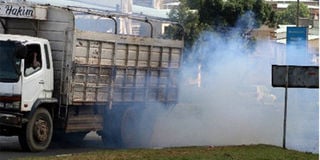MOTORING: Ways to raise transport capacity, lower pollution

Exhaust fumes engulf a Nairobi street.
What you need to know:
The surest way to reduce their quantity is to burn less fuel (preferably without reducing our capacity to transport people and goods). And the best way to improve their quality is to ensure the fuel we do burn is combusted efficiently.
There is massive scope for improvement on both counts without any painful compromise. Indeed, the right measures would increase capacity and reduce costs.
For just a moment let us set aside water and soil pollution and and focus only on air pollution — a much reduced subject.
Then let us ignore the hundreds of sources of air pollution — from industrial furnaces and smoke stacks, millions of charcoal jikos, thousands of tonnes per day of rotting urban refuse, jetliners that burn 15,000 litres of kerosene every time they take off, ships with engines the size of houses, trains, oil-fired power generators, the coughs and sneezes of 50 million people, the bums of cows and the burps of goats, the open-air burning of tyres, deliberate grass fires and accidental bush and forest blazes, and the occasional sky-filling volcano. Further reducing the issue. Instead, let us look at the single matter of motor vehicle exhaust fumes, the pantomime villain of social desire (and transport needs), the whipping boy of knee-jerk politics, and the producer of some carbon dioxide, carbon monoxide, sundry gaseous compounds of nitrogen and sulphur, and particulates of semi-combusted hydrocarbons.
These fumes are high on the global agenda because there are now more than a billion (sic, 1,000,000,000) vehicles worldwide.
Though 99.9 per cent of those are not here, whatever the level of this fraction of a fraction of the world’s overall pollution challenges, let us accept that even teeny-weeny Kenya should take whatever cost-effective measures are possible and practicable to minimise our contribution of this particular effluent in the earth’s atmosphere. What would have the greatest positive effect, most quickly, and with the least social, economic or political compromise? Here.
We do know one thing for sure and, from this we can extrapolate much: vehicle exhaust fumes are created by the combustion of fuel.
SUREST WAY
The surest way to reduce their quantity is to burn less fuel (preferably without reducing our capacity to transport people and goods). And the best way to improve their quality is to ensure the fuel we do burn is combusted efficiently.
There is massive scope for improvement on both counts without any painful compromise. Indeed, the right measures would increase capacity and reduce costs. They are, primarily:
•Development of road networks that allow traffic to flow (stop-start traffic can double the quantity of fuel consumed and increase the toxicity of fumes produced);
• Transfer of as much goods-transport as possible to railways (one train engine can do the work of 100 truck engines);
• Transfer of as much people-movement as possible to decent public and mass transportation systems (a large bus uses three times as much fuel as a car, but typically carries 30 times as many people);
• Incentives, enablers and public education to ensure vehicles are better maintained and more rationally used (optimising both fuel economy and combustion purity);
• Incentivising progressive replacement of the national fleet with newer vehicles (modern technology can be much more fuel-efficient and exhaust-pure… if well maintained and sensibly driven on roads with good traffic flows).People will do what it pays them to do, personally. So tax policies — not half-baked laws — could drive the market in the desired directions. More on that next week.





